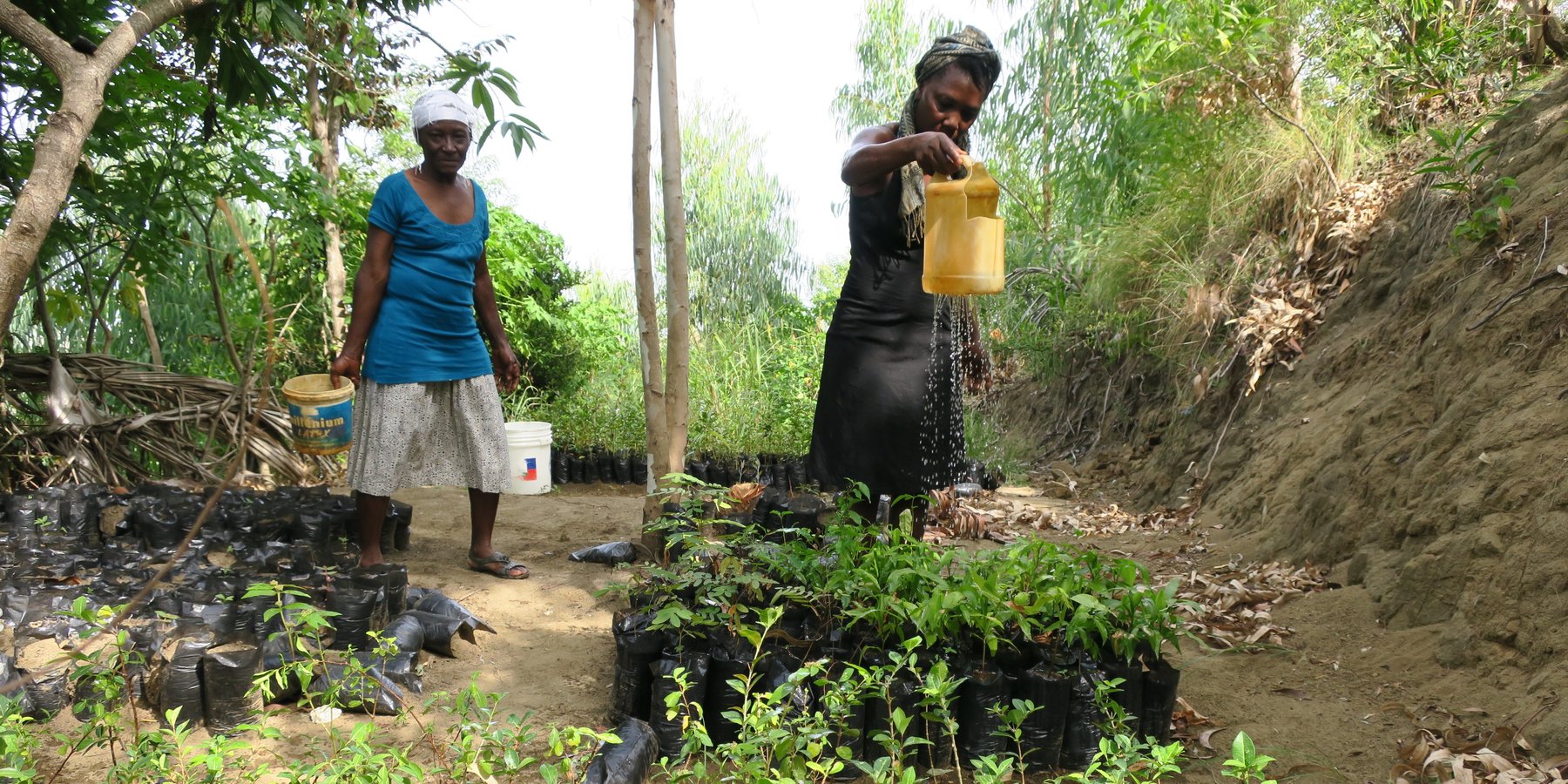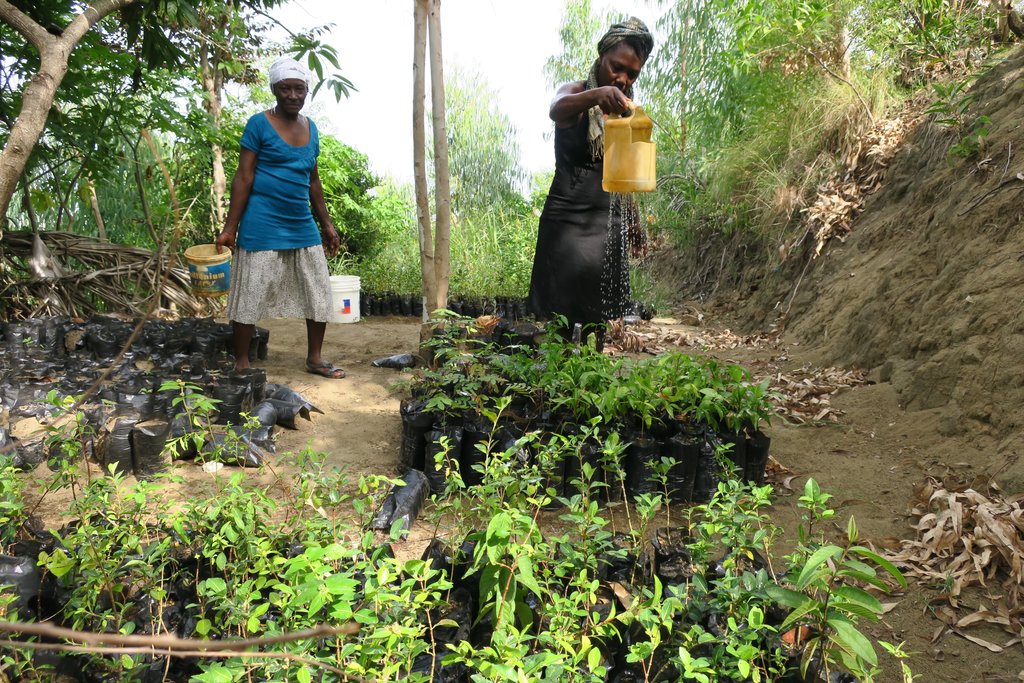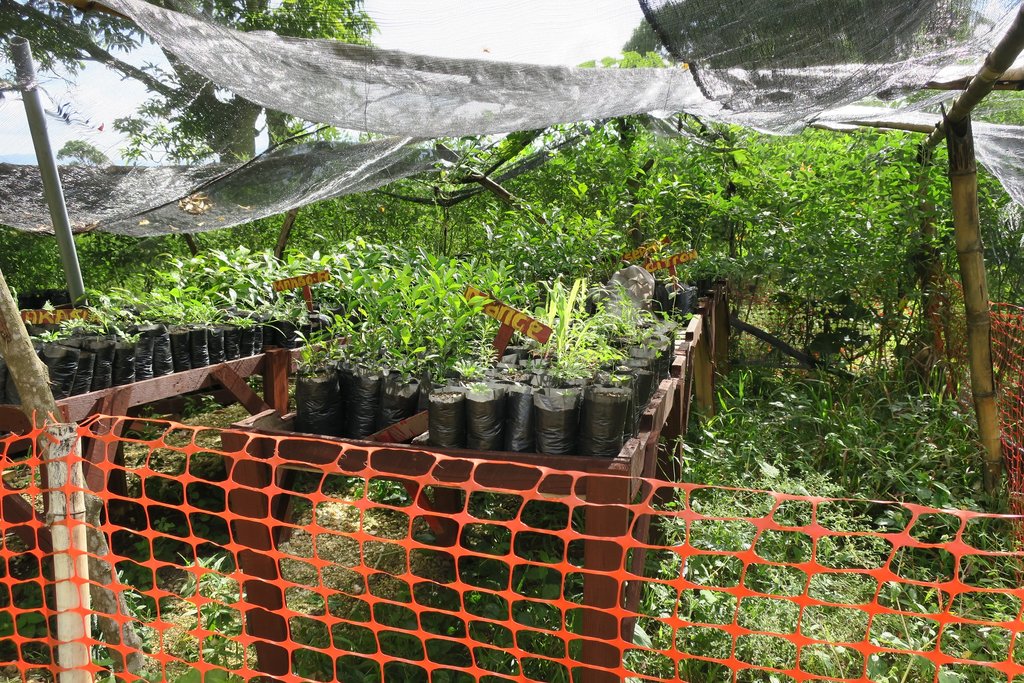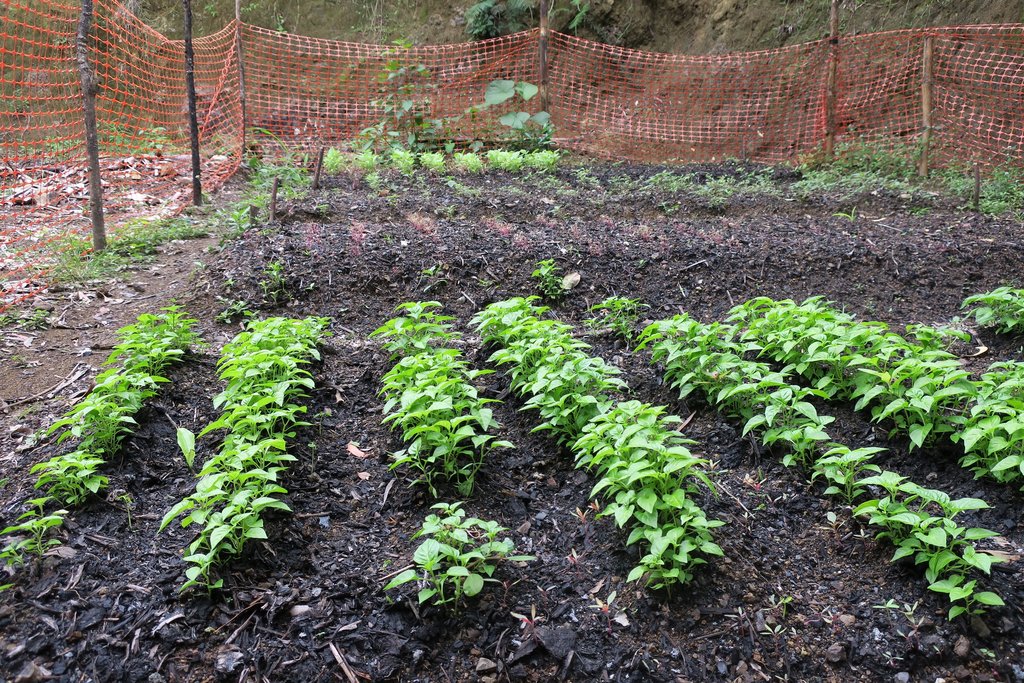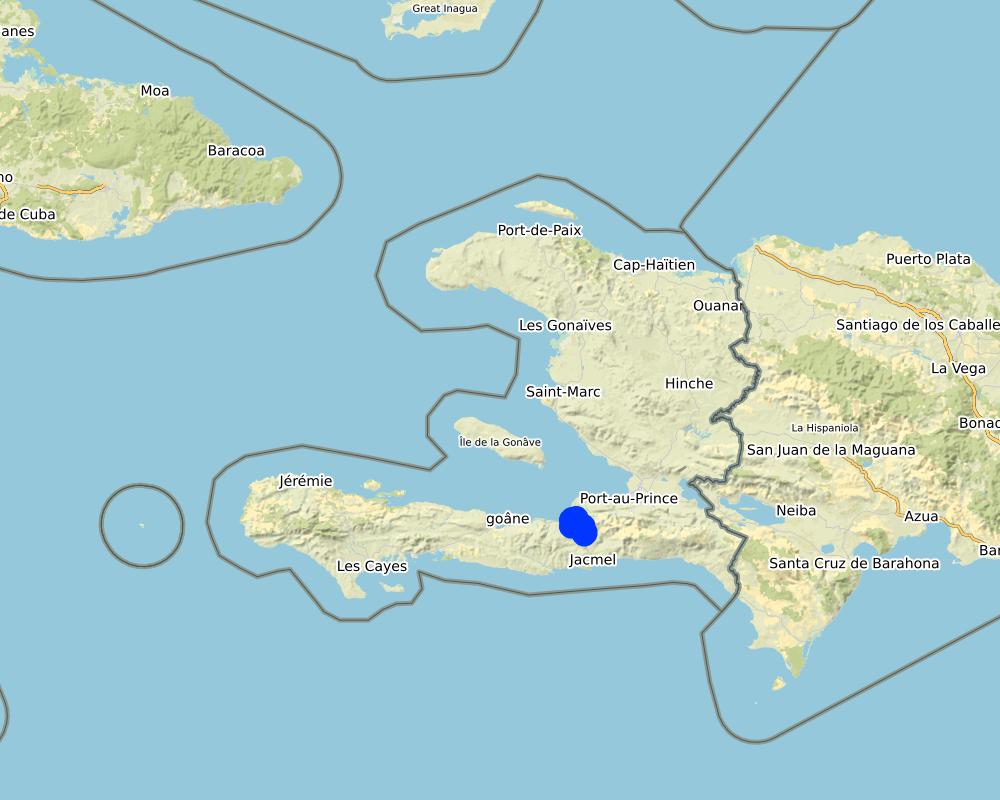Afforestation [هايتي]
- تاريخ الإنشاء:
- تحديث:
- جامع المعلومات: Joana Eichenberger
- المحررون: Hanspeter Liniger, Jean Carls Dessin
- المُراجع: Hanspeter Liniger
Afforestation
approaches_3284 - هايتي
عرض الأقسام
توسيع الكل طي الكل1. معلومات عامة
1.2 تفاصيل الاتصال بالأشخاص الرئيسيين لمصدر المعلومات والمؤسسات المعنية بتقييم وتوثيق النهج
الشخص (الأشخاص) الرئيسي لمصدر المعلومات
Technicien agroecologie:
Jeune Loius
Crois Rouge Suisse
هايتي
اسم المشروع الذي سهّل توثيق/تقييم النهج (إذا كان ذلك على صلة)
Onsite and Offsite Benefits of SLMاسم المؤسسة (المؤسسات) التي سهلت توثيق/تقييم النهج (إذا كان ذلك على صلة)
Swiss Red Cross (Swiss Red Cross) - سويسرا1.3 الشروط المتعلقة باستخدام البيانات الموثقة من خلال WOCAT
متى تم تجميع البيانات (ميدانيا)؟:
23/11/2017
يوافق جامع المعلومات والشخص (لاشخاص) الرئيسي لمصدر المعلومات على الشروط المتعلقة باستخدام البيانات الموثقة من خلال WOCAT:
نعم
1.4 المراجع الخاصة باستبيان(استبيانات) تقنيات الإدارة المستدامة للأراضي

Afforestation of arable land [هنغاريا]
Afforestation is planting trees on previously non-forested land. Trees hold the soil and reduce runoff, and thus prevent erosion of the most fertile layers. It is an effective way to rehabilitate degraded lands, being a nature-based solution which addresses flood and soil erosion impacts.
- جامع المعلومات: Brigitta Szabó
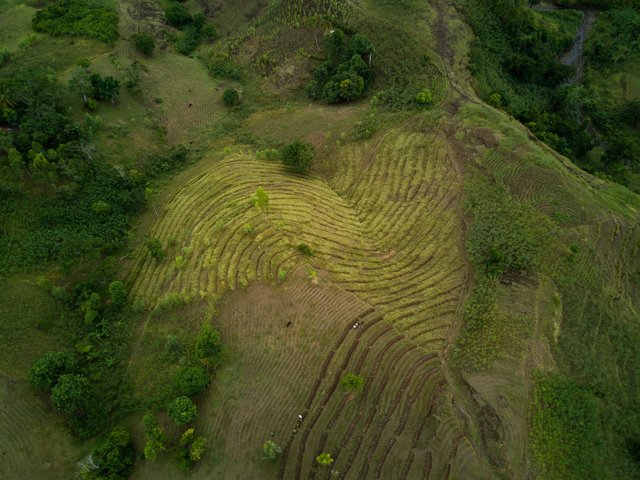
Progressive bench terraces formed by a vetiver hedge … [هايتي]
Progressive terracing technology is established through successive deposits of sediments behind (upstream) any anti-erosional structure, in this case contour strips of vetiver grass (vetiveria zizanioides). To better stabilize the slopes in the long-term, trees are planted downstream of the vetiver hedges.
- جامع المعلومات: Joana Eichenberger
2. وصف نهج الإدارة المستدامة للأراضي
2.1 وصف موجز للنهج
Dans les mornes à Léogâne, la Croix Rouge Suisse (CRS) pratique la reforestation en participation communautaire.
2.2 وصف تفصيلي للنهج
وصف تفصيلي للنهج:
Un des projets de la Croix Rouge Suisse à Léogâne est l’afforestation. Il s’agit d’une approche participative avec les OCBs (organisations communautaires de base) et les exploitants des terres. Il est essentiel de sensibiliser les membres des OCB et leurs voisins à la valeur des services écosystémiques des arbres et des forêts et de les motiver à coopérer.
L’objectif de cette approche est de reboiser certaines parties des mornes pour restaurer l'environnement ou bien pour réduire les risques de catastrophes basé sur la gestion des écosystèmes. Cependant, la Croix Rouge Suisse exige la coopération des OCB et de la participation des exploitants des terres: les communes s’organisent eux-mêmes pour réaliser des pépinières et planter les arbres. La Croix Rouge Suisse ne fournis que le savoir-faire et les petits sachets en plastique (qui ne sont pas disponible an Haïti) pour faire l’élevage les plantules.
Comme c’est une approche de participation communautaire, les techniciens de la CRS font beaucoup de sensibilisation. D’abord l’équipe de la Croix Rouge Suisse doit sensibiliser les représentants des OCBs pour qu’ils participent du projet. Ensuite, les OCBs doivent motiver tous les gens de la communauté à collaborer. C’est aux OCBs de choisir les endroits adéquats à reboiser. Une fois choisit une parcelle (et approuvé par les techniciens de la Croix Rouge Suisse), les OCBs peuvent commencer avec la mise en place des pépinières. Après quatre mois les plants sont prêts à être planté. Les membres des OCBs et les habitants de la communauté les plantent à system pluviale.
Ce que les exploitants des terres aiment au sujet de l’approche c’est qu’ils peuvent participer à restaurer l’environnement. Ils sont conscients des bénéfices des arbres concernant la dégradation des terres. Par contre ce qu’ils aiment moins c’est le fait qu’avec la reforestation ils perdent de l’espace cultivable.
2.3 صور عن النهج
2.5 البلد/المنطقة/المواقع التي تم تطبيق النهج فيها
البلد:
هايتي
المنطقة/الولاية/المحافظة:
Département de l'Ouest
مزيد من التفاصيل حول الموقع:
Léogâne
Map
×2.6 تواريخ بدء وإنهاء تنفيذ النهج
في حالة عدم معرفة السنة بالتحديد، يرجى الإشارة إلى التاريخ التقريبي لبدء النهج:
منذ أقل من 10 سنوات (مؤخرًا)
2.7 نوع النهج
- قائم على مشروع/برنامج
2.8 الغايات/الأهداف الرئيسية للنهج
Dans un bassin versant reforestation sert comme technologie de gestion des risques de désastre: En stabilisant le sol et en améliorant l'infiltration de l'eau, les arbres protègent les villes, les champs et les infrastructures en avale contre des glissements de terre et des inondations.
2.9 الظروف التي تمكن أو تعيق تنفيذ التقنية/التقنيات المطبقة بموجب النهج
المعايير والقيم الاجتماعية /الثقافية/ الدينية
- تمكين/تمكيني
توفر/الوصول إلى الموارد والخدمات المالية
- تمكين/تمكيني
التعاون/التنسيق بين الجهات الفاعلة
- تمكين/تمكيني
المعرفة حول الإدارة المستدامة للأراضي، والوصول إلى الدعم الفني
- تمكين/تمكيني
الأسواق (لشراء المدخلات وبيع المنتجات) والأسعار
- تمكين/تمكيني
عبء العمل، توفر القوى العاملة
- تمكين/تمكيني
3. المشاركة وأدوار الأطراف المعنية
3.1 أصحاب المصلحة المعنيون بالنهج وأدوارهم
- مستخدمو الأراضي المحليون/المجتمعات المحلية
Les gens de la zone, toutes les catégories (femmes, hommes, jeunes, âgées...)
Le soin de la forêt, entretien
- المنظمات المجتمعية
Organisations communautaires de base (OCBs) (femmes, hommes, jeunes, âgées...)
Sensibilisation, mise en place et soin des pépinière, planter les plants, soin de la forêt
- متخصصون في الإدارة المستدامة للأراضي / مستشارون زراعيون
Techniciens de la Croix Rouge Suisse (seulement de hommes, jeunes-âgés)
Sensibilisation, appuie techniquement
- الحكومة المحلية
Autorités locales: Conseil de l'administration communale (Casec) pour les sections communales et l'assemblé des section communale (AsEC) pour les "habitation", (hommes et femmes, avec des quota pour les femmes)
L'administration
- منظمة دولية
Croix Rouge Suisse
Appuie les OCB (organisations communautaires de base), fournis les techniciens, donne un plat chaud pour les gens que travaillent
3.2 انخراط مستخدمي الأراضي المحليين/المجتمعات المحلية في المراحل المختلفة للنهج
| انخراط مستخدمي الأراضي المحليين/المجتمعات المحلية | حدد من شارك وصف الأنشطة | |
|---|---|---|
| المبادرة/التحفيز | تفاعلي | |
| التخطيط | تفاعلي | |
| التنفيذ | تفاعلي | Les OCB sont très actives. Les exploitant de terre suivent les ordres de l'OCB. La CRS ne peut pas agir sans les OCBs. Idéalement la parcelle appartient à un membre de l'OCB. Comme ça il faut juste sensibiliser les voisins. Si l'espace n’appartient pas à un membre de l'OCB, c'est plus compliqué. Il faut donc sensibiliser le propriétaire et le convaincre des bénéfices de la reforestation. |
| الرصد/التقييم | تفاعلي | Les voisins participent à la protection, OCB doit faire de la sensibilisation pour que les gens protègent |
3.4 اتخاذ القرار بشأن اختيار تقنية/تقنيات الإدارة المستدامة للأراضي
حدد من الذي قرر اختيار التقنية/التقنيات التي سيتم تنفيذها:
- جميع الجهات الفاعلة ذات الصلة، كجزء من نهج تشاركي
اشرح:
OCB avec l'appuie technicien de la CRS
حدد على أي أساس تم اتخاذ القرارات:
- تقييم المعرفة الموثقة جيدًا بشأن الإدارة المستدامة للأراضي(اتخاذ القرارات القائمة على الأدلة)
4. الدعم الفني وبناء القدرات وإدارة المعرفة
4.1 بناء القدرات/التدريب
هل تم تقديم التدريب لمستخدمي الأراضي / الأطراف المعنيين الآخرين؟:
نعم
- les OCB
شكل التدريب:
- في العمل
- مناطق العرض
- اجتماعات عامة
- دورات
المواضيع المغطاة:
stabilisation de sol
4.2 خدمة استشارية
هل يملك مستخدمو الأراضي وصولا إلى خدمة استشارية؟:
نعم
حدد ما إذا كانت الخدمة الاستشارية متوفرة:
- في حقول مستخدمي الأراضي
4.3 تعزيز المؤسسات (التطوير التنظيمي)
هل تم إنشاء أو تعزيز مؤسسات من خلال هذا النهج؟:
- نعم، قليلا
حدد المستوى (المستويات) التي تم فيها تعزيز أو إنشاء المؤسسات:
- محلي
صف المؤسسة والأدوار والمسؤوليات والأعضاء وما إلى ذلك.
OCB
- appuie technique
4.4 الرصد والتقييم
هل يشكل الرصد والتقييم جزءا من النهج؟:
نعم
إذا كانت الإجابة بنعم، فهل من المقصود استخدام هذه الوثائق للمراقبة والتقييم؟:
نعم
4.5 البحوث
هل كانت البحوث جزءًا من النهج؟:
كلا
5. التمويل والدعم المادي الخارجي
5.1 الميزانية السنوية لمكون الإدارة المستدامة للأراضي في النهج المذكور
إذا لم تكن الميزانية السنوية الدقيقة معروفة، قم بالإشارة إلى نطاقها:
- < 2000
5.2 الدعم المالي/المادي المقدم لمستخدمي الأراضي
هل حصل مستخدمو الأراضي على دعم مالي/ مادي لتنفيذ التقنية/ التقنيات؟:
نعم
إذا كانت الإجابة بنعم، حدد نوع (أنواع) الدعم والشروط والمزودين:
Sachets pour la pépinière (our OCBs);
Pour une activité officielle: plat chaud pour les participants
5.3 إعانات لمدخلات محددة (بما في ذلك العمالة)
- بناء
| حدد المدخلات التي تم دعمها | إلى أي مدى | حدد الإعانات |
|---|---|---|
| petits sachets pour la pépinière | ممول بالكامل | |
إذا كان العمل من قبل مستخدمي الأراضي مدخلاً جوهريًا، فهل كان:
- تطوعي
التعليقات:
Plat chaud dans le cadre d'une activité officielle
5.4 الائتمان
هل تم توفير ائتمان في إطار نهج أنشطة الإدارة المستدامة للأراضي؟:
كلا
5.5 حوافز أو وسائل أخرى
هل تم استخدام حوافز أو أدوات أخرى لتشجيع تنفيذ تقنيات الإدارة المستدامة للأراضي؟:
كلا
6. تحليل الأثر والتصريحات الختامية
6.1 آثار النهج
هل ساهم النهج في تمكين مستخدمي الأراضي المحليين وتحسين مشاركة الأطراف المعنية؟:
- لا
- نعم، قليلا
- نعم، باعتدال
- نعم، إلى حد كبير
Ils sont intéressés à protéger la forêt et ils participent. Ils sont fiers de ses ouvres.
هل ساعد النهج مستخدمي الأراضي على تنفيذ وصيانة تقنيات الإدارة المستدامة للأراضي؟:
- لا
- نعم، قليلا
- نعم، باعتدال
- نعم، إلى حد كبير
C'est une approche participative, ils font tout eux-mêmes.
هل نجح النهج في تحسين التنسيق والتنفيذ الفعال من حيث التكلفة لأنشطة الإدارة المستدامة للأراضي؟:
- لا
- نعم، قليلا
- نعم، باعتدال
- نعم، إلى حد كبير
Surtout à long terme il y a beaucoup de bénéfices.
هل نجح النهج في تعبئة/تحسين الوصول إلى الموارد المالية لتنفيذ الإدارة المستدامة للأراضي؟:
- لا
- نعم، قليلا
- نعم، باعتدال
- نعم، إلى حد كبير
Ça coût moins en terme de capital financier.
هل أدى النهج إلى تحسين معرفة وقدرات مستخدمي الأراضي على تنفيذ الإدارة المستدامة للأراضي؟:
- لا
- نعم، قليلا
- نعم، باعتدال
- نعم، إلى حد كبير
C'est comme une expérience pilote. Ça va aider les gens à le faire chez eux.
هل أدى النهج إلى تحسين معرفة وقدرات الأطراف المعنية الأخرى؟:
- لا
- نعم، قليلا
- نعم، باعتدال
- نعم، إلى حد كبير
Les exploitants des terres qui n’appartiennent pas à une organisation ne sont pas vraiment inclue parce qu'ils sont moins fiables: des fois on pense qu'il y aura 7 participants mais seulement 2 arrivent.
هل ساهم النهج في بناء/تعزيز المؤسسات والتعاون بين الأطراف المعنية؟:
- لا
- نعم، قليلا
- نعم، باعتدال
- نعم، إلى حد كبير
Des fois les OCBs gainent des nouveaux membres.
هل ساهم النهج في تمكين الفئات المحرومة اجتماعيا واقتصاديا؟:
- لا
- نعم، قليلا
- نعم، باعتدال
- نعم، إلى حد كبير
La fertilité du sol va augmenter et du coup ces gens auront plus de rendement (peut planter le café).
هل أدى النهج إلى تحسين المساواة بين الجنسين وتمكين النساء والفتيات؟:
- لا
- نعم، قليلا
- نعم، باعتدال
- نعم، إلى حد كبير
Ce sont surtout des femmes qui s'occupent des pépinières.
هل شجع النهج الشباب/الجيل القادم من مستخدمي الأراضي على الانخراط في الإدارة المستدامة للأراضي؟:
- لا
- نعم، قليلا
- نعم، باعتدال
- نعم، إلى حد كبير
Le jeune se rendent compte des bénéfices écologiques des forêts.
هل أدى النهج إلى تحسن في مسائل حيازة الأراضي / حقوق المستخدمين التي أعاقت تنفيذ تقنيات الإدارة المستدامة للأراضي؟:
- لا
- نعم، قليلا
- نعم، باعتدال
- نعم، إلى حد كبير
L'approche demande que tout le monde met ensemble ses parcelles, mais ce n'est pas tous les gens qui sont d'accord.
هل أدى هذا النهج إلى تحسين الأمن الغذائي / تحسين التغذية؟:
- لا
- نعم، قليلا
- نعم، باعتدال
- نعم، إلى حد كبير
Mais seulement à long terme (une dizaine d'années)
هل أدى النهج إلى تحسين الوصول إلى الأسواق؟:
- لا
- نعم، قليلا
- نعم، باعتدال
- نعم، إلى حد كبير
Peut-être en terme touristique, ça peut attirer des gens qui aiment la nature.
هل أدى النهج إلى تحسين الوصول إلى المياه والصرف الصحي؟:
- لا
- نعم، قليلا
- نعم، باعتدال
- نعم، إلى حد كبير
A l'eau, parce que le débit des sources devrait augmenter. Même les sources sèches devraient réapparaître.
هل أدى النهج إلى استخدام طاقة/ مصادر طاقة أكثر استدامة؟:
- لا
- نعم، قليلا
- نعم، باعتدال
- نعم، إلى حد كبير
هل أدى النهج إلى تحسين قدرة مستخدمي الأراضي على التكيف مع التغيرات المناخية/الظواهر المناخية المتطرفة والتخفيف من الكوارث المرتبطة بالمناخ؟:
- لا
- نعم، قليلا
- نعم، باعتدال
- نعم، إلى حد كبير
Les services écosystémiques des forêts sont mis à valeur: Grâce à la nouvelle couche végétale, l'impact de la pluie sur le sol est diminué, l'infiltration de l'eau dans les sols est améliorée et les forêts servent aussi comme des brise-vent.
هل أدى النهج إلى توفير فرص عمل ودخل؟:
- لا
- نعم، قليلا
- نعم، باعتدال
- نعم، إلى حد كبير
Après de 10ènes des années on a les revenus p.ex. du café ou du cacao.
6.2 المحفز الرئيسي لقيام مستخدمي الأراضي بتنفيذ الإدارة المستدامة للأراضي
- زيادة الإنتاج
à long terme
- الحد من تدهور الأراضي
à long terme
- الحد من مخاطر الكوارث
à long terme
- الوعي البيئي
- تعزيز المعرفة والمهارات في مجال الإدارة المستدامة للأراضي
- تحسينات جماليية
La beauté de la région
6.3 استدامة أنشطة النهج
هل يمكن لمستخدمي الأراضي المحافظة على استدامة ما تم تنفيذه من خلال النهج (بدون دعم خارجي)؟:
- نعم
إذا كانت الإجابة بنعم، صف كيف:
Ce pour ça que la CRS a priorisé cette approche participative.
6.4 نقاط قوة/مزايا النهج
| نقاط القوة/ المزايا/ الفرص من وجهة نظر مستخدمي الأراضي |
|---|
| Après la sensibilisation ils voient les bénéfices comme la protection de l'environnement. |
| نقاط القوة/ المزايا/ الفرص من وجهة نظر جامع المعلومات أو غيره من الاشخاص الرئيسيين لمصدر المعلومات |
|---|
| Restauration de l'environnement physique |
6.5 نقاط الضعف/ العيوب في المنهج وطرق التغلب عليها
| نقاط الضعف/ المساوىء/ المخاطر من وجهة نظر مستخدم الأراضي | كيف يمكن التغلب عليها؟ |
|---|---|
| Moins de terre cultivable | Sensibilisation |
| L'espace inaccessible aux bétails | Sensibilisation |
| نقاط الضعف/ المساوىء/ المخاطر من وجهة نظر جامع المعلومات أو غيره من الاشخاص الرئيسيين لمصدر المعلومات | كيف يمكن التغلب عليها؟ |
|---|---|
| C’est un travail à long terme. | |
| Nécessite beaucoup d'énergie |
7. المراجع والروابط
7.1 طرق جمع/مصادر المعلومات
- زيارات ميدانية، مسوحات ميدانية
Visites de 3 pépinières, visite de rampes vivantes qui étaient en cours de reboisement.
- مقابلات مع المتخصصين/الخبراء في الإدارة المستدامة للأراضي
Technicien agroécologiste
الروابط والوحدات المواضيعية
توسيع الكل طي الكلالروابط

Afforestation of arable land [هنغاريا]
Afforestation is planting trees on previously non-forested land. Trees hold the soil and reduce runoff, and thus prevent erosion of the most fertile layers. It is an effective way to rehabilitate degraded lands, being a nature-based solution which addresses flood and soil erosion impacts.
- جامع المعلومات: Brigitta Szabó

Progressive bench terraces formed by a vetiver hedge … [هايتي]
Progressive terracing technology is established through successive deposits of sediments behind (upstream) any anti-erosional structure, in this case contour strips of vetiver grass (vetiveria zizanioides). To better stabilize the slopes in the long-term, trees are planted downstream of the vetiver hedges.
- جامع المعلومات: Joana Eichenberger
الوحدات المواضيعية
لا يوجد وحدات مواضيعية


